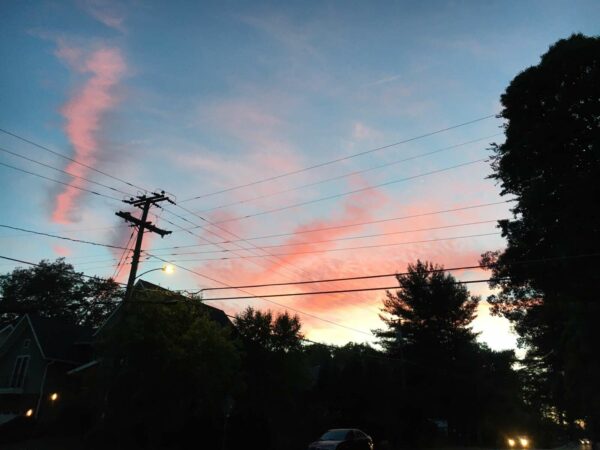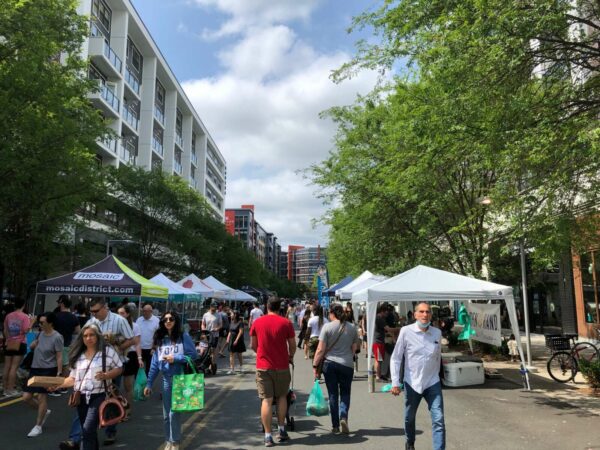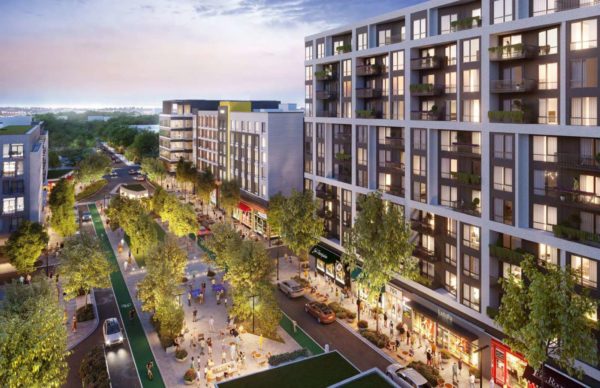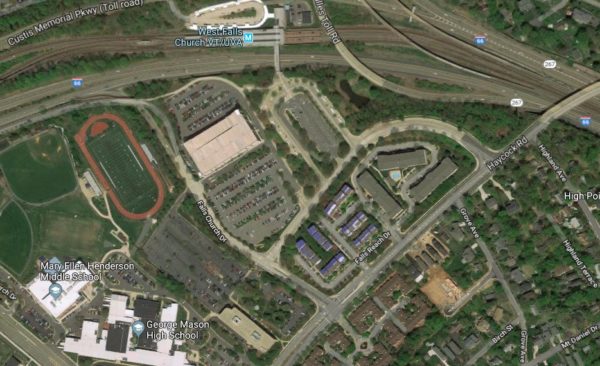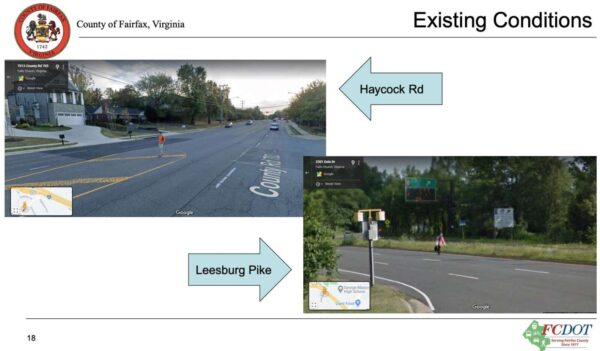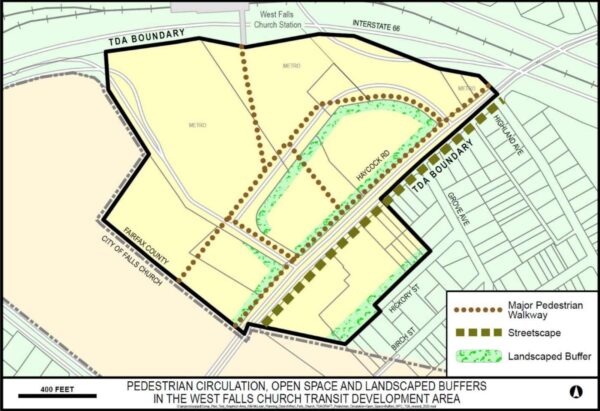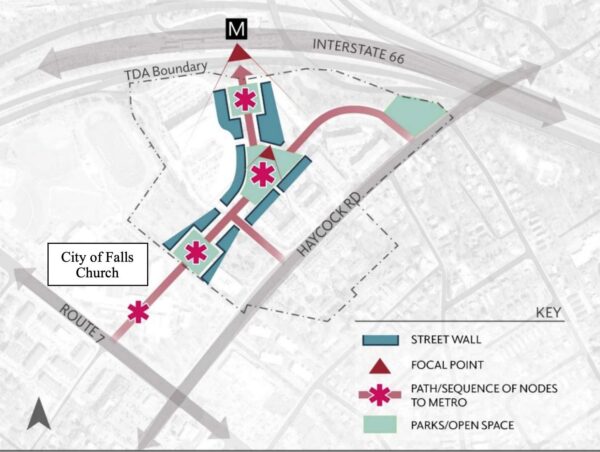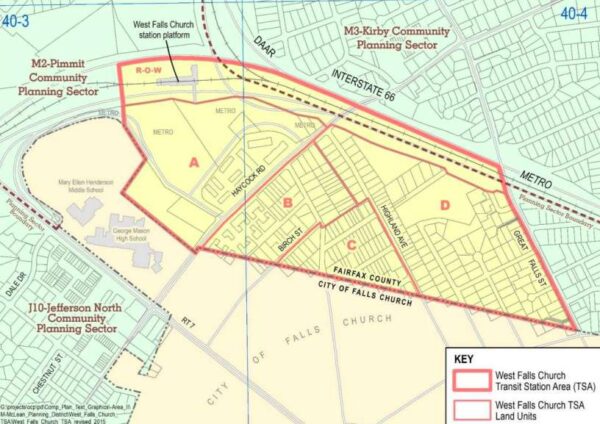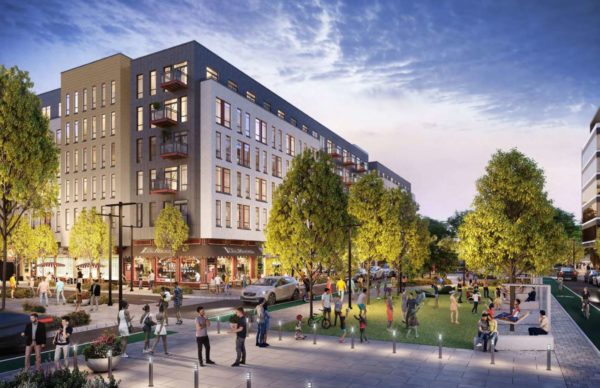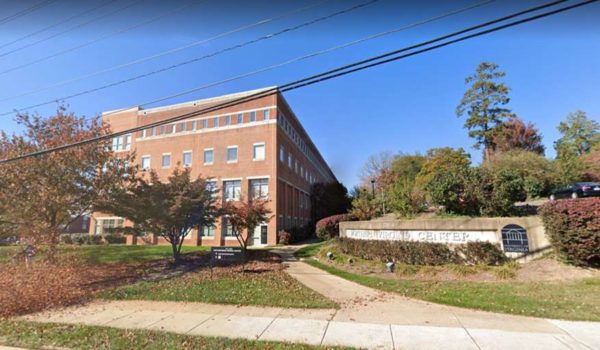Metro to Phase Out Diesel Buses — The Metro Board of Directors approved a plan yesterday (Thursday) to phase out buses powered by diesel and natural gas over the next two decades with the goal of having a zero-emissions fleet by 2045. The transit agency will start adding electric buses in 2023 and cease purchases of emission-producing buses by 2030, a timeline that critics argued is too slow. [The Washington Post]
Approval of West Falls Church Plan Anticipated — “The Fairfax County Planning Commission, at its scheduled meeting next week, is expected to endorse the proposed amendment to the county’s comprehensive plan that will open up the potential for a large-scale coordinated development of WMATA’s West Falls Church Metro station property and adjacent property occupied by Virginia Tech.” [Falls Church News-Press]
Mosaic District to Open Rollerskating Rink — The Mosaic District in Merrifield will hold a grand opening celebration for its new Skateland rink from 5:30 to 10 p.m. tomorrow (Saturday). The disco-themed event will feature live music from the band Groovalicious and support Pride Month with 50% of ticket sales going to FCPS Pride. [EDENS]
Madison Baseball Vies for State Title — James Madison High School’s baseball team is set to compete in the 2021 Virginia High School League Class 6 state tournament tomorrow after defeating Lake Braddock 6-0 on Tuesday (June 22). If the Warhawks win, it would be the program’s first state championship since 2015 and its fourth ever. [Sun Gazette]
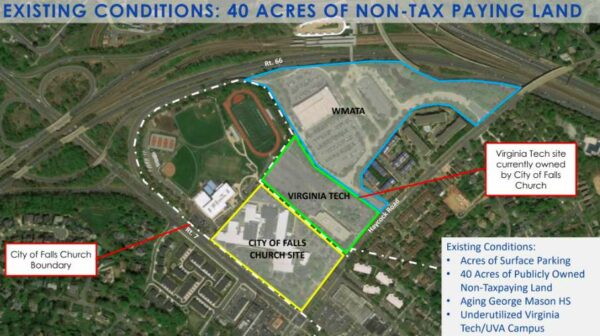
Concerns raised by both local citizens and Fairfax County Planning Commission members over the impact of a new West Falls Church Metro station development plan prompted the commission to defer a vote on the project on Wednesday (June 16).
The West Falls Church Metro station is one of the most underutilized stations in the Metro system, and the Washington Metropolitan Area Transit Authority has enlisted developer EYA to turn the site into a mixed-use development.
The plan was endorsed by a task force appointed by Dranesville District Supervisor John Foust, but at Wednesday’s public hearing, several nearby residents and civic association representatives spoke out with concerns about the project — though others praised it as an improvement over the existing space.
“There are several focused criticisms and concerns raised about the current proposal by the [McLean Citizens Association] and by some of the nearby residents, who feel that we need to go further than this plan suggests,” said Dranesville District Planning Commissioner John Ulfelder.
Much of the criticism focused around the effect of traffic brought by the project on nearby roads that the county acknowledges were not made to support a sizable increase in density.
Braddock District Commissioner Mary Cortina said she was concerned that the plans fail to adequately address pedestrian safety.
“The text I see in the pedestrian area talks about convenience and comfort: it doesn’t talk about safety,” Cortina said. “This is life and death. We have to call out safety where we have pedestrian sections because that should be a priority.”
County staff said a follow-up study will look at identifying funding for pedestrian safety and traffic improvements for nearby streets that are outside of the scope of the current project but will still likely be affected by it.
“Haycock Road and Route 7 prevent a lot of people from crossing safely [to the Metro],” said Tim Kutz, a transportation planner with the Fairfax County Department of Transportation. “That’s something we’re going to look at further in the transportation plan looking at the surrounding neighborhood. It’s important that people have an opportunity to bike and walk safely…A lot of older neighborhoods don’t have sidewalks, don’t have crosswalks, and don’t have connectivity.”
Kutz said the funding for those future pedestrian improvements is something the county would “have to explore” later.
Some nearby residents commented that they support the project, notably Cheryl Smith, who represented the Gates at West Falls Condominiums and served as the majority vote for the West Falls Church TSA Task Force.
Smith argued that the project would be a net increase in terms of quality of life for those surrounding the project, but others disagreed.
“The WMATA site is not suitable,” said Adrienne Whyte, representing the recently-launched Reclaim Fairfax County group. “This is a lovely but limited fiction.”
Whyte said the West Falls Church Metro station is intended to be a neighborhood-serving station rather than a site for significant developments.
In the middle was Phil Cooke from the McLean Citizens’ Association, who said the MCA supported the developer’s plans, but with the provision that the county must further study ways to address the potential consequences of increased density and congestion.
“[This] will strain Route 7 congestion further than it already is,” Cooke said. “Folks will seek to avoid Haycock and Route 7 and exit the back way, increasing local congestion.”
At Ulfelder’s suggestion, the board voted unanimously to defer its decision on the comprehensive plan amendment to the June 30 meeting, to collect further feedback and reflect on public comment before the Commission votes on the project.
Westbound I-66 to Close Overnight Starting Tomorrow — “Work at the Interstate 66 and Capital Beltway interchange will require a full I-66 closure in the westbound direction over several upcoming days. The Virginia Department of Transportation said westbound I-66 will be closed at I-495 nightly from Tuesday, June 15 to Saturday, June 19. Closure hours are 11 p.m. to 5 a.m. nightly and until 6 a.m. on Saturday and Sunday.” [Patch]
Vienna Reaffirms Commitment to Library Parking Project — “Vienna officials still can back out of an agreement with Fairfax County to build a new Patrick Henry Library with a parking structure, but now the town financially has something to lose. Vienna Town Council members on June 7 reconfirmed the town’s participation in the agreement and agreed to support the project’s design phase.” [Sun Gazette]
Falls Church Chamber of Commerce Supports Amendment — “The board of directors of the Falls Church Chamber of Commerce formally signed off on a letter to the Fairfax County Planning Commission in advance of its meeting next Tuesday. The letter, sent over the signature of Falls Church Executive Director Sally Cole, expressed the Chamber’s strong support for an amendment to the Fairfax County Comprehensive Plan to permit mixed use development at WMATA’s West Falls Church Metro station site.” [Falls Church News-Press]
McLean Home of Retired Football Quarterback for Sale — “In April, the veteran quarterback Alex Smith announced his retirement from the NFL. Now Smith is leaving the Washington, DC, metro behind. He’s listed his gorgeous mansion in McLean, VA, for $6.7 million.” [Sun Sentinel]

(Updated 6/11) A plan to overhaul one of the Metro system’s least-used stations is headed to the Fairfax County Planning Commission next week, but surrounding the new project is a complex network of advocates, issues, and jurisdictional questions that’s built Katamari Damacy-style over the last two years of public engagement.
As the project to transform the area around the West Falls Church Metro station starts to move forward, advocates and opponents alike are already starting to look at the next stage of transportation questions down the road.
The proposed comprehensive plan amendment aims to turn the area near the West Falls Church Metro station into a mixed-use district with office, retail, and residential uses more typical of areas near Metro stations.
With the withdrawal of Virginia Tech taking the filling out of the development sandwich, the two pieces of the plan are the City of Falls Church parcel, with mixed-use developments around a central stretch of park and open space, and the area adjacent to the Metro station.
The first phase of the project is scheduled for a planning commission public hearing on Wednesday (June 16) before going to the Board of Supervisors on July 13, after which the Washington Metropolitan Area Transit Authority’s development team will still need to get specific plans approved.
So far, most of the public discussion about the project has involved transportation.
Evan Goldman, executive vice president of acquisitions for site developer EYA, says an expanded roadway parallel to the crowded Haycock Road should help relieve some of the local traffic, along with a new exit off I-66 running directly to the West Falls Church Metro station.
“There’s no question that what is being built here is 100% better than what is there today,” Goldman said. “This will have dedicated bike lanes on almost all the streets.”
Goldman says the concerns raised so far have mainly focused on the single-family residential neighborhoods near the development, where there are insufficient sidewalks in some places.
“It’s specifically because of the location, surrounded by single-family neighborhoods in an area where there are existing traffic issues,” Goldman said. “The density is sized for the capacity of what the traffic can handle to make sure we’re trying to be respectful of neighbors in terms of height and density.”
Goldman says lower density requirements will also allow more of the buildings to be delivered together, so the project can be brought online all at once.
The reaction from surrounding neighbors to the project has been mixed.
Paul Rothstein, one of the representatives from nearby residential development The Villages on a task force to review the project, has argued that the increased density will pose a hazard to nearby residents, who will feel the ripple effect of traffic from the site on streets not built to handle it.
“Even though I view pedestrian infrastructure remediation as mostly Fairfax County’s responsibility and not [EYA’s], your development will increase traffic in the surrounding areas and increase the risk to pedestrians,” Rothstein wrote in a letter to the developer.
Rothstein has been pushing for EYA to endorse a McLean Citizens Association resolution on the project, which notes that the traffic issues at the site remain unresolved.
“To quote the father of the injured child, ‘I also hope that the developers, who emphasize building walkable communities, will support the MCA resolution and thus make sure that walkability in existing communities does not deteriorate as a result of new communities,'” Rothstein wrote. “Adoption of the MCA resolution still will permit substantial development at the same time as promoting the safety of your neighbors, including their children.”
Goldman says current plans for the development include dedicated crossings on Haycock and Leesburg Pike, but Rothstein’s concern is for neighborhood children walking to Haycock Elementary along more crowded streets.
Goldman says EYA’s obligations for traffic improvement are primarily at the development site and not the broader region around the station.
Cheryl Sim, another nearby resident, agreed that, by and large, EYA is not responsible for the entire area, but it still has some obligations.
“The County and VDOT have long ignored this area and its needs,” Sim said. “However, EYA fronts for WMATA in this exercise. And, WMATA, based upon its Joint Development Guidelines and Principles from May 2020 place the onus on the developer.” Read More
Falls Church is looking to set up a new governing authority to handle some of the finances for its ambitious West Falls Church Economic Development Project — a new mixed-use development the city hopes can rival the nearby Mosaic District in Merrifield.
The new Community Development Authority (CDA) will be financially-focused, aimed at administering the bonds and debt service for local projects, as well as imposing special taxes on businesses within its zone.
The West Falls CDA will be the first of its kind created in Falls Church, though similar CDAs are in place in Ballston Quarter in Arlington and for the Mosaic District in Fairfax.
“A CDA can finance such projects by issuing bonds and then requesting that the locality impose special taxes or a special assessment on properties in the district to pay the debt service on such bonds,” city staff said in a report. “This ordinance is before City Council for creation of the CDA only, and bond issuance will require further Council approval down the road.”
Staff presented an overview of the proposal to the Falls Church City Council during its work session on Monday (May 17).
City Manager Wyatt Shields explained that community development authorities result from property owners petitioning their local government to create the organization, generally so that they can “gain public improvements” within the specific district where they are located.
In the case of the potential West Falls CDA, the petitioners are the future leaseholders of the site, which is currently owned by the City of Falls Church. That includes Falls Church Gateway Partners, the developer group comprised of EYA and Hoffman & Associates.
“There would be a special assessment paid only by those who live in that special district to pay for those public improvements,” Shields said. “There is no tax impact for taxpayers who live outside the district.”
The plan for the West Falls Church Economic Development Project is to create a sprawling mixed-use area with a residential component as well as 123,000 square feet of retail anchored by a grocery store, office space, and a hotel.
The report says the intent is for the CDA to issue $12 to $15 million in bonds that would kickstart some of the planned infrastructure improvements and fund under-grounding utilities.
The CDA will be managed by a five-member board appointed by the city.
The proposal is scheduled to go to a public hearing on Monday (May 24) before returning to the city council for final approval on June 28. If approved, the CDA would start meeting in July, with bond sales beginning February 2022.
Image via City of Falls Church
The arduous journey toward a re-imagined West Falls Church Transit Station Area is drawing to a close with the last two approvals slated for this summer.
“I want to thank the entire team for two-and-a-half years of dedicated work on behalf of the Dranesville district,” Dranesville District Supervisor John Foust said during a community meeting on Tuesday (May 11). “This has been a long, difficult process, and as a consequence, the product is much better. The time was well spent. The product is good — and getting better — and we still have some time.”
The development plan will go before the Fairfax County Planning Commission on June 16 and the Board of Supervisors on July 13. The plan was narrowly approved by a task force that voted 5-3-1 earlier this month.
When the proposed plan was presented to the community for the first time on Tuesday, however, some residents expressed concerns about traffic along Haycock Road, pedestrian safety, and distance from Virginia Tech’s property.
“I’m not anti-development, but I’m really concerned,” one attendee said. “I’ve been trying to get our streets to be safer as they’re crowded with cars.”
Predicting that the new I-66 exit ramp will pour traffic into the new community, she asked staff to find a way to make it inconvenient to “pop out onto Haycock Road” for those looking to get to Tysons, DC or Arlington “as fast as possible.”
“I know every area is screaming for sidewalks, but one thing you could do is paint the speed limit or look at other creative, inexpensive ways that communities have found to reduce the speed and the number of cut-thru cars, and make better buffers and calming measures for people who live here, pay taxes and are part of the community,” she said.
The draft plan includes language directing the county to develop a West Falls Church Active Transportation Plan with recommendations for transportation improvements that will increase connectivity, fill in missing or inadequate facilities, and promote walking and bicycling.
“County staff are working on this,” county transportation planner Tim Kutz said. “A follow-up motion will be approved after the plan amendment goes forward and we’ll be reaching out in the fall to continue engaging with you. Getting your perspective is going to be critical in developing recommendations to increase active transportation in the area.”
The plan includes mitigation measures for what people perceive as “bad traffic,” with signal timing, new signals and reconfigured intersections, county planner Bryan Botello said.
Residents worried there was little to ensure the local government implements those changes, but staff said these changes will happen when developers come into the picture.
“The improvements approved are recommendations that would happen when the development team is actually going to the rezoning and development review stage,” senior transportation planner Bob Pikora said. “The comprehensive plan informs what we will be doing in the zoning and review phases, but the developments will be up to the development team.”
More landscaped buffers and green spaces have been added to the plan, according to staff.
New plans have not materialized for the Virginia Tech property after the university nixed a project to expand its Northern Virginia Center with a design school and other facilities. But some task force members were keen to get a buffer between the campus and nearby housing.
“We’ve added an additional landscaped buffer between Virginia Tech and the Villages condominium, and added additional language that strengthens the buffer, and creates a linear park,” Botello said.
Housing will be separated from Virginia Tech by landscaped buffers, a pedestrian walkway, a road and streetscaping, according to the plan.
The new plan envisions a sequence of parks through the area instead of the courtyard featured in the current comprehensive plan.
“There are really a lack of options for accessible parks south of I-66, so it was certainly a priority for us when we were drafting the plan,” Botello said, noting that the park areas shown below could take the form of pocket parks, urban greens, or a civic plaza.
A recreational park is envisioned at the northeast corner of the study area, at the corner of Haycock Road and Metro Access Road.
Images via Fairfax County
(Updated 4/7/21) After two years, the West Falls Church TSA Task Force pushed through a tense nearly-three hour meeting to finally approve an updated plan that will guide the overhaul of one of the Metro system’s most underused stations.
In recent meetings, some lingering divides on the task force sometimes escalated into heated moments between those with concerns about pedestrian safety and those pushing for approval of the plan to usher in new growth to the area.
“I think this plan exemplifies the transit-oriented development goals [and] represents an intensity of uses that we would expect for a vibrant, active Metro station,” Bryan Botello, a Fairfax County planner who helped oversee the task force, said.
Botello argued that the plan addresses two of the main concerns raised by task force members, namely ones related to pedestrian connectivity and safety and the efficiency of the area’s road network.
“I think this plan really balances the priorities of all road users,” he said. “…It should satisfy everyone and improves connectivity to the Metro for pedestrians and provides more efficient traffic operations.”
Covering roughly 156 acres near the West Falls Church Metro station, the new plan is a complicated patchwork of transportation and development suggestions.
The task force did hit a stumbling block when one of the major impetuses for its creation — the development of the Virginia Tech campus — was abruptly canceled earlier this year.
While county staff endorsed the plan, two of its most vocal critics, Christopher Szara and Paul Rothstein, who represent the nearby residential development The Villages, said the plan doesn’t go far enough in protecting and improving pedestrian transportation options in the area.
A motion by Rothstein to delay approval of the plan until further study by the Virginia Department of Transportation was struck down by the rest of the task force.
“We have had concerns…regarding traffic and the impact of the project outside of the scope of our discussion here, and the added impact of the WMATA project,” Szara said. “Traffic is a concern and I’m not convinced its been adequately addressed. I know over the last year we’ve been lulled into submission with regards to traffic, but having been a commuter for many many years I know how bad it can be, and having my son go to Haycock and him walking to school, I know how treacherous that can be.”
Szara, Rothstein, and task force chair David Wuehrmann voted no on the plan but were beaten by five votes in favor and one abstension.
McLean Citizens Association representative Darren Ewing had been a leading voice pushing for approval of the plan that evening.
“First and foremost, the [plan amendment] we’re entertaining here is consistent with the MCA’s long standing that density is appropriate at Metro sites,” Ewing said. “We have a failing Metro station with pre-COVID Metro ridership levels at 25,000 trips per day, one of the lowest number of trips in the entire Metro system. It’s not an inviting station, it’s a suburban parking lot, and it doesn’t encourage walking or biking. Even the park-and-ride is operating at 60% capacity pre-COVID.”
An email from MCA President Rob Jackson noted that, while the MCA is on record as supporting higher density at Metrorail stations, it has not adopted a position on the West Falls Church Comprehensive Plan Amendment.
“Our Planning & Zoning Committee will be preparing a resolution setting forth a recommended position that is expected to be presented to the MCA board at its June meeting,” Jackson said.
Following the task force’s approval, the plan will be discussed in a community meeting on Tuesday (May 11) before going to the Planning Commission on June 16 and Board of Supervisors on July 13.
Image via Fairfax County
Not all grocery stores are created equal.
There isn’t exactly a dearth of grocery stores in the area around the planned West Falls Church Economic Development Project, inspiring some confusion when it was announced the project will be anchored by 123,000 square feet of retail primarily consisting of a grocery store.
But at a recent meeting last week on the project, developer EYA argued that the city is big enough to accommodate multiple grocery retailers.
“Within this market, because it’s such a high density area leading towards both to Tysons as well as towards downtown Falls Church, the numbers within that three mile ring is high,” Evan Goldman, executive vice president of acquisition and development for EYA, said. “Even though you do have a lot of grocery stores, you have different types of grocery stores.”
The identity of the grocer expected to move into the extensive mixed-use development remains under wraps, sealed by a nondisclosure agreement, according to City of Falls Church staff.
Goldman noted that some grocery store chains operate as primary stores for staples, while others live symbiotically with those chains as providers for more niche products.
“Like Trader Joe’s, that’s something where somebody will often cross-shop,” Goldman said. “They’ll go to Trader Joe’s and Giant or Whole Foods or Harris Teeter. The grocery store we’re bringing to bear is something more unique and different as well, so it might be something as well where people cross-shop to grocers.”
The cross-shopping trend for grocery stores was called into question during the pandemic, however, when more shoppers started to focus on getting all their grocery needs at a single store. Whether that endures after the pandemic is too early to say.
“Grocery stores, of all the retail tenants, probably have the most sophisticated demographic software when they determine locations,” Goldman said. “So they clearly think there’s demand for their product here, and we agree based on what we’ve seen.”
Final action on the West Falls development — and its mystery tenant — is scheduled for May 24.
Image via City of Falls Church
J.R. Stockyards Inn for Sale — The 1.18-acre property that currently houses one of the oldest restaurants in Tysons hit the market in early March, with a new owner expected to be chosen by the end of April. The Fairfax County Board of Supervisors approved a redevelopment of the site in October that would replace the Stockyards with a 26-story mixed-use building. [Washington Business Journal]
Connolly Urges Congress to Follow Virginia’s Lead in Legalizing Weed — “Another big progressive win here in Virginia,” Rep. Gerry Connolly (D) said after the Virginia General Assembly voted yesterday to legalize marijuana starting July 1. “I hope my colleagues in the House and Senate will join me in supporting the MORE Act to legalize marijuana nationwide.”[Gerry Connolly/Twitter]
Falls Church Schedules Town Hall on Gateway Development — Falls Church City staff and the developer of the West Falls Church project will present updates and answer questions on April 14 at noon. The city will also hold a town hall meeting on April 15 to discuss its proposed FY 2022 budget and new capital improvements program. [City of Falls Church]
Clemyjontri Carousel and Train Among Facilities Reopening This Spring — Fairfax County Park Authority facilities have started to reopen for the spring, with hours expected to expand further into the summer. Visitors are encouraged to buy tickets in advance, because amusements will operate at reduced capacity, though drop-in tickets will be available on-site if they do not sell out online. [FCPA]
Proof of Job Searches Will Soon Be Required for Unemployment Benefits Again — “The Virginia Employment Commission says it will start notifying unemployment benefit recipients of the return of job-search requirements starting in May. To qualify, or continue to qualify, for unemployment benefits in Virginia, those filing claims must provide evidence…of at least two job applications each week for VEC review.” [WTOP]
Photo by Joanne Liebig
Plans to overhaul the area around the West Falls Church Metro station are slowly coming together, but some deep divisions over what shape that future will take remain, even as Fairfax County’s three-year effort to update its vision for the area nears a conclusion.
Appointed by Dranesville District Supervisor John Foust in 2019, the West Falls Church Transit Station Area Task Force is a small group with a big task: help determine what the approximately 24 acres of transit-accessible land should look like.
In the group’s penultimate meeting last night, one of the primary points of contention was how Virginia Tech’s 7.5-acre campus on Haycock Road should be separated from residences.
Dwyn Taylor, representing Virginia Tech, was left to address the fallout of the university’s decision not to move forward with plans to expand its Northern Virginia Center with a design school and other facilities.
What will or won’t be built at the site is still up in the air, and Taylor was pressed by task force member Paul Rothstein about how any future construction will divide the campus from nearby residential properties like The Villages.
Taylor answered that he couldn’t provide too many specifics on what the alignment of the campus will look like, because it was still being determined what the curriculum of the school will be.
“What does your curriculum have to do with buffering?” Rothstein said. “So it’s acceptable to you to be fronting right next to our community? Virginia Tech was not a very good neighbor to us. We asked specific questions and never got very good answers…I [hope Taylor] will take back to project executives that it’s important for Virginia Tech to consider being good neighbors to the community they say they’re proud to be part of.”
Task force chair David Wuehrmann noted that buffers are included in the proposed draft amendment to Fairfax County’s comprehensive plan, which was last updated on April 1, but Rothstein said his concern is that what constitutes a barrier is left vague.
One of the few examples of landscape buffering included in the plan is a “linear park,” which Rothstein says could constitute much less than what anyone on the task force is imagining unless specified otherwise.
“If it’s a linear trail, like W&OD trail, that’s not really a buffer,” Rothstein said. “It’s nice language, but nothing says [the] buffer will be at least X. It sounds nice, but there are no teeth in it.”
Photo via Google Maps


